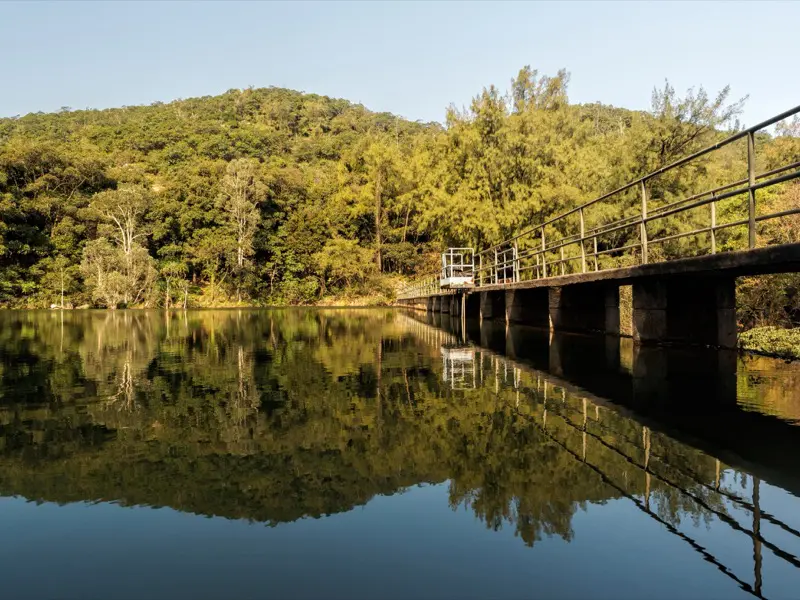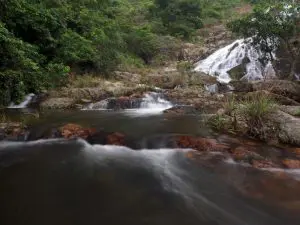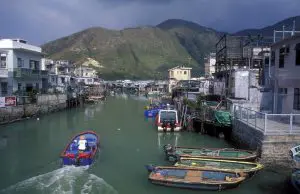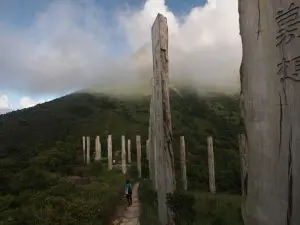In southeast Lantau, there’s an area that’s easily overlooked, yet can make for a fine day outing: the Chi Ma Wan Peninsula.
Old Man Mountain and a Dragon’s Tail
Head to Lantau for a wild outing and, chances are, you’ll be bound for the central hills – maybe to climb one or both of Sunset and Lantau peaks, or aiming to stride along nearby stretches of Lantau Trail.
But in the southeast, there’s another area that’s easily overlooked, yet can make for a fine day outing: the Chi Ma Wan (Sesame Bay) Peninsula. The landscape is fashioned from a mass of granite, forming a hilly interior and coastal headlands between small bays. There are few residents, in scattered hamlets and a wouldbe upscale development. Only a slender road runs across the north of the peninsula, forking to a ferry pier and smaller roads linking two disused prisons.
The Chi Ma Wan Country Trail, at 18.5km the longest country trail in Hong Kong, starts in the north, and makes a looping circuit above shorelines and up and over the peninsula’s highest point, Lo Yan Shan. While it may take eight hours to complete the circuit – perhaps making it daunting given you also have to travel to and from home – there are options for following shorter routes.
Hamlets and Buffalo Fields

If you’ve never been to this part of Lantau before, it’s well worth stopping off at Shap Long, an area of hamlets facing Chi Ma Wan. Abandoned fields have become a grassy area where water buffalo graze. The area’s marred by ugly new development of “small houses” at the top of the old fields, but is elsewhere rural, typically tranquil, with a hotchpotch collection of somewhat ramshackle buildings among trees and shrubs by the mouth of a tidal creek.
Reclusive Reservoir

Above the coastline south of Shap Long, there’s a small reservoir nestled in the hills. You could reach it via the road passing the deserted prisons and their staff quarters, or will pass by if you walk the country trail. It’s small, perhaps only a couple of hundred metres long, and is splendidly secluded, with dense woodland fringing the shores. The sturdy dam is maybe four or five storeys high, and was evidently built to help nearby villagers when they were still farmers, as a map gives the name Shap Long Irrigation Reservoir.
In this sheltered locale, the water may be calm, and from the dam you can enjoy views with trees and hills reflected in the water. The path skirting the north shore heads for a tiny bridge across a stream, amidst vegetation so lush it’s like a jungle.
Lung Mei – Dragon Tail
Onwards, and southwards! The peninsula beyond the reservoir seems remote, the dense woodland often obscuring views of landmarks that might be useful for finding your way. There are occasional trail signs, however; especially at Lung Mei – Dragon Tail.
Though itself appearing on trail signs, Lung Mei is a nondescript place, barely enlivened by a statue of a dragon’s tail looking rather like a squashed pineapple. Its significance lies in it being the prime hub in the Chi Ma Wan trails network.
The country trail passes through here, heading eastwards and then south, to make almost a full circuit around a hill. While the trail affords views across the sea to Cheung Chau and passes an area called “Rock Wonder” – where the hillside is sprinkled with giant granite boulders – you could readily ignore it if you haven’t time and energy for a full exploration of Chi Ma Wan Peninsula: there’s an easy shortcut between Lung Mei and the country trail near the reservoir.
The western section of the country trail almost hugs contours as it passes above the peninsula’s south and west coasts.
Another trail drops down to a coastal village, Tai Long Wan.
Firefly Village and Discovery Bay Wannabe
Tai Long Wan – one of four places in Hong Kong with a name meaning “Big Wave Bay” – is a remote village, reached only by paths, or by sampans from nearby Cheung Chau. It’s almost deserted, though there is some organic farming, and even a Firefly Museum in one of the village houses. There’s a fine beach in front of it and just around a headland to the west lies its bizarre neighbour, Sea Ranch.
Sea Ranch was built by Hutchison group in the late 1970s, and was supposed to become a luxury estate for people wanting to live in a quiet bay beyond the city. But even “Superman” Li Ka-shing could not lead it to success, and it has since languished, with relatively few of the spacious apartments still lived in. The clubhouse became abandoned; I’ve seen photos of a long dead dog on a sofa, a stairway up into shadows, looking creepy as a horror film.
But casual visitors are not welcome, so it’s best to avoid or just bypass Sea Ranch.
Hills and Crags and Panoramic Vistas

While you could explore the peninsula without getting higher or more challenging than hillside contour trails, doing so would mean missing out on the best parts: Lo Yan Shan and the nearby craggy hilltop.
There’s a trail to Lo Yan Shan from Lung Mei, or you could follow the country trail from the reservoir. There are steep flights of steps, places where the paths are like corridors between bamboo and trees.
At 303 metres, Lo Yan Shan – Old Man Mountain – is the highest peak on the peninsula. It affords fine views over the sea east of Lantau, with Hei Ling Chau in the foreground, Ping Chau beyond. But it’s not the best summit around here.

Walk north, with more downhill stretches and steps uphill, and you arrive at a craggy hilltop that perhaps has no name. This is a magnificent place to rest and admire the scenery, with Pui O below, the main hills of Lantau soaring beyond it, Cheung Sha beaches to the west.
Getting there
You can walk to the north of the peninsula from Pui O, following the road through Ham Tin and then up to the start of the country trail, and onwards to Shap Long. There are also infrequent ferries to Chi Ma Wan from Cheung Chau and Mui Wo.
– Written for the South China Morning Post.















